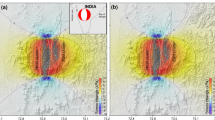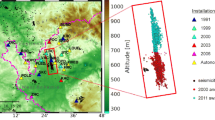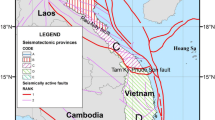Abstract
The West Halmahera Swarm (WHS) event occurred from November to December 2015. A seismic station located in Ternate City detected at least 1000 shocks of magnitude (M) ≥ 1 and 11 shocks of M ≥ 4.5. Our estimation yields a cumulative seismic moment of 3.87 × 1021 N m, which is equivalent to a single M 8.3 earthquake. We conducted a field survey after the swarm event and found that roads and residents’ houses experienced cracks, while some parts of buildings were destroyed during the event. We find that the 2015 WHS was located just below the Jailolo volcano and was strongly associated with volcanic activity.
Similar content being viewed by others
Avoid common mistakes on your manuscript.
1 Introduction
West Halmahera, Indonesia, is considered a tectonically active region located at the convergence of three major plates, namely the Eurasian plate, Philippine Sea Plate, and Australian Plate (Lallemand et al. 1998). Socquet et al. (2006) suggested that the western region of the Molucca Sea is part of a micro block called the Manado block. The Philippine Sea plate, located in the eastern part of the Molucca Sea, dips to the west, and Nichols et al. (1990) suggested that the Philippine Trench terminates to the northeast of Halmahera. To the south, the Australian plate moves northward toward Eurasia and interacts complexly with the NW–SE convergence between the Sundablock and the Philippine Sea Plate (Widiwijayanti et al. 2004).
The surface thrusts on the west and east sides of the Molucca Sea are directed outwards towards an adjacent arc associated with the Halmahera Thrust and the Sangihe Thrust (McCaffrey 1982). Evidence for the Halmahera Thrust can be found in the southern Philippines, while the Sangihe Thrust cannot be traced northward towards Mindanao Island (Hall 2002). The collision between the Sangihe and Halmahera arcs resulted in westward and eastward thrusts over the Sangihe and Halmahera volcanic arcs (Hall and Wilson 2000). The 2014 magnitude M w 7.1 Molucca Sea earthquake is an example of a seismic event associated with crustal deformation in this region (Gunawan et al. 2016a). Figure 1 shows the tectonic background of the study area.
In November 2015, the Indonesian Agency for Meteorological, Climatological, and Geophysics (BMKG) reported a series of earthquake events with M ≤ 5 in West Halmahera. The West Halmahera volcanic arc is composed of 13 volcanoes ranging from north to south, namely Dukono, Tobaru, Ibu, Gamkonora, Todoko-Ranu, Jailolo, Hiri, Gamalama, Tidore, Mare, Moti, Kiebesi (Makian), and Tigalalu (Fig. 2). Following Supriatna (1980), the physiography of western Halmahera is characterized by the presence of an alignment of volcanic cones, which extends from Jailolo city in the south to Galela city in the north, where the Dukono, Ibu, and Gamkonora volcanoes are still active at present. Apandi and Sudana (1980) defined the Quaternary volcanic arc in the west of Halmahera, which is mostly formed by volcanic island cones and is the site of the Gamalama and Kiebesi volcanoes, which remain active. These five active volcanoes are classified as A type volcanoes, which means they have erupted at least once since 1600.
Here we present in detail the seismicity of the 2015 West Halmahera swarm (WHS) evolution during the period from November to December 2015. Also, we present the results of our field survey in West Halmahera, Indonesia, after the November to December 2015 earthquake swarm. Hereinafter, we then refer to the entire earthquake swarm sequence as the 2015 WHS.
2 Seismic Activity and Observation
2.1 Earthquake Swarm
Between November and December 2015, an earthquake swarm was recorded in West Halmahera by a seismic station located in Ternate City, which was installed and maintained by the BMKG (Fig. 2). Seismic activity began on 2 November in West Halmahera, and by 6 November the swarm had concentrated below the volcanic area of Jailolo. The swarm occurred intensively on 7 and 8 November, before significantly reducing in activity, only to restart intensively on 16 November. The swarm activity reached its peak on 19 November, and reduced the next day. On 1 December, the activity again increased and since then has been reduced. Figure 3 shows the daily earthquake swarm evolution from November to December 2015.
The 2015 WHS included at least 1000 shocks of M ≥ 1, with 11 shocks of M ≥ 4.5. We estimated that the total cumulative seismic moment of the swarm was 3.87 × 1021 N m, and thus our estimation is equivalent to a single M 8.3 earthquake. We find that seismic energy released by the 2015 WHS was much higher than the seismic energy released during the March 1996 earthquake swarm event at the Akutan volcano in Alaska, USA (Lu et al. 2000). Figure 4 shows the time series of the number of earthquakes per day with M > 1 and the cumulative seismic moment during earthquake swarm events for 34 days since 1 November 2015.
2.2 Field Observations
We conducted a field survey in West Halmahera Regency, North Maluku Province of Indonesia in December 2015 to observe the environmental effect and the building damage caused by the 2015 WHS. West Halmahera has an area of 2.612 km2 with a population of more than 100,000 inhabitants. We focused mainly on the region surrounding Jailolo volcano, where the Government of Indonesia received reports of damage to infrastructure. Our field survey location is shown in Fig. 5.
During the 2015 WHS, residents in Jailolo city reported continuous ground shaking as well as cracks in their houses, and parts of some buildings were also destroyed during the event (Fig. 6). In response to this situation, the Government of Indonesia, through the Local Agency for Disaster Management (BPBD), prepared a basecamp for organizing support for residents affected by this disaster (Fig. 7).
During our field survey, we observed several cracks resulting in damage to roads, houses, and other infrastructures. In the Bobanehena region, we observed a significant crack along the road that continued towards residential buildings (Fig. 8). This crack continued towards the shoreline, where a new hot spring had appeared. Cracks resulted in damage to the floor and the walls of the local buildings. Several houses were also destroyed by the event. Due to continuous activity of the swarm, the residents chose to sleep outside using tents provided by the BPBD. The Indonesian National Board for Disaster Management (BNPB) reported as many as 1593 buildings with damage induced by the 2015 WHS event.
We found a crack in the Saria region, in the southern part of Jailolo. Because the crack occurred on a slope region, we suspect that this might indicate a future landslide location (Fig. 9). Residents also reported damage to their houses in the Idamdehe region to the north of Jailolo. However, when we went to this location, we found that the damage to buildings was minor and insignificant.
3 Preliminary Analysis
Our seismic analysis suggests that the 2015 WHS was located just below the Jailolo volcano. This finding shows that the swarm was strongly associated with Jailolo’s volcanic activity (Fig. 10). Jailolo is a stratovolcano with a height of 3707 feet. Even though Jailolo’s cone and its surrounding area are composed of volcanic materials, there is no record of its activity since ~1600. However, there seem to be remnants of old volcanic activity such as hot springs, traces of a young lava flow in the eastern part, a small caldera in the southwestern part of the volcano, and former craters.
Seismic activity of the earthquake swarm could become part of the volcano’s eruption sequence process, as was in the case of swarm events in recent prior eruptions such as Redoubt volcano (Power et al. 1994) and Mount Spuur volcano (Power et al. 1995), both in Alaska. However, earthquake swarms are not necessarily considered as part of a volcanic eruption, as evidenced by the 1988 seismic swarm at Dutton volcano in Alaska (Lu et al. 2000). Hence, one can investigate and analyze the tectonic process in the region using modern equipment, such as a dense Global Positioning System (GPS) network or seismic network.
GPS has become an essential tool for understanding the Earth’s tectonic activity. It can be used to analyze deformation on a fault system (Ito et al. 2012; Meilano et al. 2012), strain accumulation during inter-seismic phases (Hanifa et al. 2014; Ohkura et al. 2015), co-seismic deformation (Ito et al. 2016; Gunawan et al. 2016b), post-seismic deformation (Anugrah et al. 2015; Ardika et al. 2015; Alif et al. 2016), and the rheological structure of a region (Gunawan et al. 2014).
The availability of a GPS network was important in the 2015 WHS case, and is crucial for the analysis of future hazards in relation to the swarm event. It is very interesting to determine if the 2015 WHS is related to the next eruption of Jailolo. Unfortunately, GPS stations are not available around Jailolo. One great example comes from dense GPS network of Japan, named the GNSS Earth Observation Network System (GEONET) (Sagiya 2004), which provides useful information as a base for analysis of the tectonic process during a swarm event (Toda et al. 2002). Using the Japanese case of the Izu Islands earthquake swarm of 2000, Nishimura et al. (2001) showed that GPS was capable of detecting subsidence and extension between stations. They showed that magma migrated up to 30 km distance. Considering that Indonesia is prone to earthquakes and other disaster activities, we strongly suggest the use of continuous GPS around Jailolo volcano, or any other potential natural disaster location in the country.
4 Conclusions
The seismic station located in Ternate City detected at least 1000 shocks of M ≥ 1 and 11 shocks of M ≥ 4.5 during the 2015 WHS event. Our estimation yields a cumulative seismic moment of 3.87 × 1021 N m, which is equivalent to a single M 8.3 earthquake. We conducted a field survey after the swarm event and found that roads and residents’ houses experienced cracks, while some parts of buildings were destroyed. Our findings suggest that the swarm was strongly associated with the volcanic activity of Jailolo.
References
Alif SM, Meilano I, Gunawan E, Efendi J (2016) Evidence of postseismic deformation signal of the 2007 M.85 Bengkulu Earthquake and the 2012 M.86 Indian Ocean Earthquake in Southern Sumatra, Indonesia, based on GPS data. J Appl Geod 10(2):103–108. doi:10.1515/jag-2015-0019
Anugrah B, Meilano I, Gunawan E, Efendi J (2015) Estimation of postseismic deformation parameters from continuous GPS data in northern Sumatra after the 2004 Sumatra–Andaman earthquake. Earthq Sci 28(5–6):347–352. doi:10.1007/s11589-015-0136-x
Apandi T, Sudana D (1980) Geologic map of Ternate quadrangle, North Maluku, scale 1:250.000. Geological Research and Development Center, Bandung, Indonesia
Ardika M, Meilano I, Gunawan E (2015) Postseismic deformation parameters of the 2010 M7.8 Mentawai, Indonesia, earthquake inferred from continuous GPS observations. Asian J Earth Sci 8:127–133. doi:10.3923/ajes.2015.127.133
Gunawan E, Sagiya T, Ito T, Kimata F, Tabei T, Agustan Ohta Y, Meilano I, Abidin HZ, Nurdin I, Sugiyanto D (2014) A comprehensive model of postseismic deformation of the 2004 Sumatra–Andaman earthquake deduced from GPS observations in northern Sumatra. J Asian Earth Sci 88:218–229. doi:10.1016/j.jseaes.2014.03.016
Gunawan E, Kholil M, Meilano I (2016a) Splay-fault rupture during the 2014 Mw7. 1 Molucca Sea, Indonesia, earthquake determined from GPS measurements. Phys Earth Planet Inter 259:29–33. doi:10.1016/j.pepi.2016.08.009
Gunawan E, Meilano I, Abidin HZ, Hanifa NR, Susilo (2016b) Investigation of the best coseismic fault model of the 2006 Java tsunami earthquake based on mechanisms of postseismic deformation. J Asian Earth Sci 117:64–72. doi:10.1016/j.jseaes.2015.12.003
Hall R (2002) Cenozoic geological and plate tectonic evolution of SE Asia and the SW Pacific: computer-based reconstructions, model and animations. J Asian Earth Sci 20(4):353–431
Hall R, Wilson MEJ (2000) Neogene sutures in eastern Indonesia. J Asian Earth Sci 18(6):781–808
Hanifa NR, Sagiya T, Kimata F, Efendi J, Abidin HZ, Meilano I (2014) Interplate coupling model off the southwestern coast of Java, Indonesia, based on continuous GPS data in 2008–2010. Earth Planet Sci Lett 401:159–171
Ito T, Gunawan E, Kimata F, Tabei T, Simons M, Meilano I, Agustan Ohta Y, Nurdin I, Sugiyanto D (2012) Isolating along‐strike variations in the depth extent of shallow creep and fault locking on the northern Great Sumatran Fault. J Geophys Res Solid Earth 117(B6). doi:10.1029/2011JB008940
Ito T, Gunawan E, Kimata F, Tabei T, Meilano I, Agustan Ohta Y, Ismail N, Nurdin I, Sugiyanto D (2016) Co-seismic offsets due to two earthquakes (Mw6.1) along the Sumatran fault system derived from GNSS measurements. Earth Planets Space 68:57. doi:10.1186/s40623-016-0427-z
Lallemand SE, Popoff M, Cadet JP, Bader AG, Pubellier M, Rangin C, Deffontaines B (1998) Genetic relations between the Central and Southern Philippine Trench and the Sangihe. J Geophys Res 103(B1):933–950
Lu Z, Wicks C, Power JA, Dzurisin D (2000) Ground deformation associated with the March 1996 earthquake swarm at Akutan volcano, Alaska, revealed by satellite radar interferometry. J Geophys Res 105(21):21483–21495
McCaffrey R (1982) Lithospheric deformation within the Molucca Sea arc-arc collision: evidence from shallow and intermediate earthquake activity. J Geophys Res Solid Earth 87(B5):3663–3678
Meilano I, Abidin HZ, Andreas H, Gumilar I, Harjono H, Kato T, Kimata F, Fukuda Y (2012) Slip rate estimation of the Lembang Fault West Java from geodetic observation. J Disaster Res 7(1):12–18
Nichols G, Hall R, Milsom J, Masson D, Parson L, Sikumbang N, Dwijayanto B, Kallagher H (1990) The southern termination of the Philippine Trench. Tectonophysics 183(1):289–303
Nishimura T, Ozawa S, Murakami M, Sagiya T, Tada T, Kaidzu M, Ukawa M (2001) Crustal deformation caused by magma migration in the northern Izu Islands, Japan. Geophys Res Lett 28(19):3745–3748
Ohkura T, Tabei T, Kimata F, Bacolcol TC, Nakamura Y, Luis AC, Pelicano A, Jorgio R, Tabique M, Abrahan M, Jorgio E, Gunawan E (2015) Plate convergence and block motions in Mindanao Island, Philippine as derived from campaign GPS observations. J Disaster Res 10(1):59–66
Power JA, Lahr JC, Page RA, Chouet BA, Stephens CD, Harlow DH, Murray TL, Davies JN (1994) Seismic evolution of the 1989–1990 eruption sequence of Redoubt Volcano, Alaska. J Volcanol Geoth Res 62(1):69–94
Power JA, Jolly AD, Page RA, McNutt SR (1995) Seismicity and forecasting of the 1992 eruptions of Crater Peak Vent, Mount Spurr Volcano, Alaska; an overview, in The 1992 Eruptions of Crater Peak Vent, Mount Spurr Volcano, Alaska, edited by T.E.C. Keith. US Geol Surv Bull 2139:149–159
Sagiya T (2004) A decade of GEONET: 1994–2003—the continuous GPS observation in Japan and its impact on earthquake studies. Earth, Planets and Space 56(8):2–3
Socquet A, Simons W, Vigny C, McCaffrey R, Subarya C, Sarsito D, Boudewijn A, Spakman W (2006) Microblock rotations and fault coupling in SE Asia triple junction (Sulawesi, Indonesia) from GPS and earthquake slip vector data. J Geophys Res Solid Earth 111(B8). doi:10.1029/2005JB003963
Supriatna S (1980) Geologic map of Morotai Quadrangle, North Maluku, scale 1:250.000. Geological Research and Development Center, Bandung, Indonesia
Toda S, Stein RS, Sagiya T (2002) Evidence from the AD 2000 Izu islands earthquake swarm that stressing rate governs seismicity. Nature 419(6902):58–61
Wessel P, Smith WHF (1998) New, improved version of the generic mapping tools released. EOS Trans AGU 79(47):579
Widiwijayanti C, Tiberi C, Deplus C, Diament M, Mikhailov V, Louat R (2004) Geodynamic evolution of the northern Molucca Sea area (Eastern Indonesia) constrained by 3-D gravity field inversion. Tectonophysics 386(3):203–222
Acknowledgements
We are grateful to two anonymous reviewers and the Editor for their helpful comments and suggestions. This study was partially funded by the Australian Department of Foreign Affairs and Trade (DFAT) for Graduate Research on Earthquake and Ministry of Research and Higher Education No. PN-7-06-2016. Some of the figures are made using GMT software (Wessel and Smith 1998).
Author information
Authors and Affiliations
Corresponding author
Rights and permissions
About this article
Cite this article
Gunawan, E., Ghozalba, F., Syauqi et al. Field Investigation of the November to December 2015 Earthquake Swarm in West Halmahera, Indonesia. Geotech Geol Eng 35, 425–432 (2017). https://doi.org/10.1007/s10706-016-0117-4
Received:
Accepted:
Published:
Issue Date:
DOI: https://doi.org/10.1007/s10706-016-0117-4














